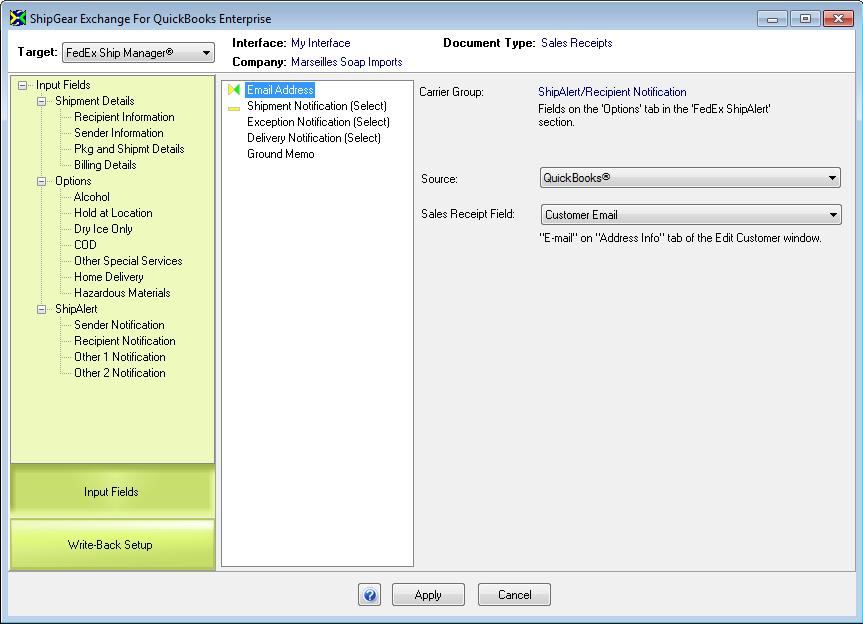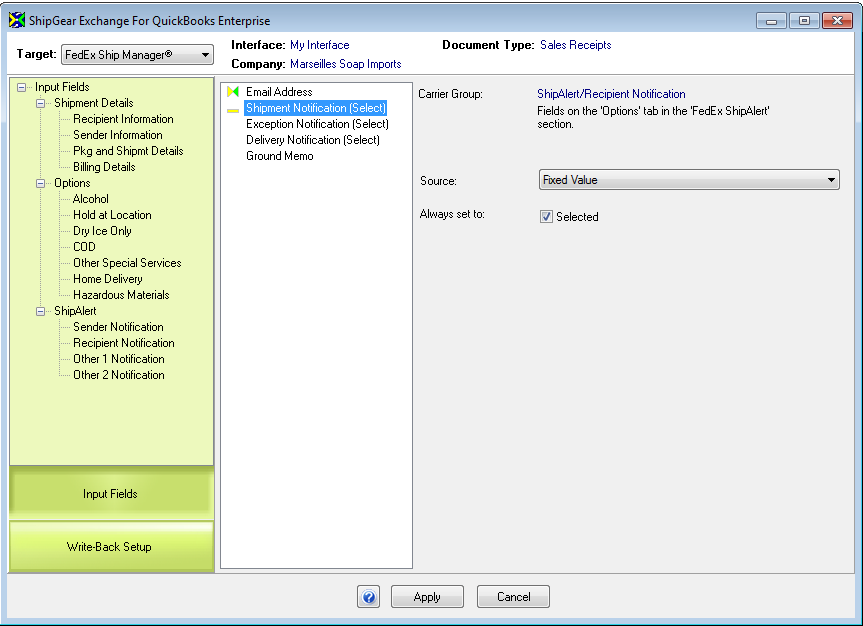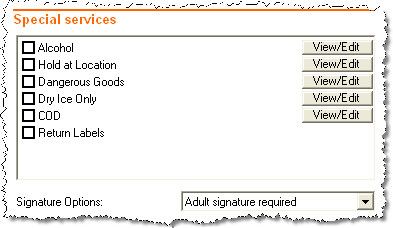FedEx Field Mapping and Value Translations
Field Mapping
In order to populate the FedEx Ship Manager®
fields with the correct shipping data from QuickBooks, ShipGear has a
mapping system that defines which fields in QuickBooks are mapped to fields
in Ship Manager. For example, in Customers
> Invoices > Edit Customers (in QuickBooks), the "Type"
field by default is mapped to the "Commercial/Residential" flag
in Ship Manager. So, if you select a QuickBooks value of "Residential"
for a customer, the "This is a residential address" check box
is automatically enabled in Ship Manager when you ship to this customer.
This is called Field Mapping. Some field maps are included in the ShipGear
default interface. You may also customize field mapping to suit your company.
This section explains how to access field mapping, explains the
Edit Interface window components, and covers default and customized field
mapping. Value translations are discussed within this section as well.
In
the ShipGear Exchange window, click the Customize Interface button.
Click the document type (Invoices, Customers, or Sales
Receipts) to access the edit interface screen, which allows you to
customize how QuickBooks fields are mapped to Ship Manager input fields.

Select FedEx Ship Manager from the Target drop-down
list.
At the top of the Customize Interface window, ShipGear displays the Interface,
the currently selected Company, and the Document Type.
The Input fields consist of a tree-style list of the FedEx fields organized
by group. When you select a group, its fields or subgroups become active
in the center pane. A description of the selected group or field appears
in the right-most pane, along with the current map settings and value
translations.

Key
 : Field is mapped
to a fixed value
: Field is mapped
to a fixed value
 : Field is mapped
to QuickBooks value
: Field is mapped
to QuickBooks value
Default Field Mapping Example
Some fields are mapped in ShipGear by default, such as in the Recipient
Notification group. This group handles how recipient notifications are
sent. Let’s look at this group as an example of how fields are mapped
to achieve a specific result … in this case, to automatically send recipient
notifications for each shipment via e-mail using the QuickBooks
Customer’s e-mail address.
To see the current mapping for the fields in this group:
Expand the Options group from
the Input Fields tree.
Select the Recipient Notification
subgroup.
Now let’s go over the mapping.
If you select the Email Address field from the middle panel, you’ll
see an example of a field that is mapped to a QuickBooks
source, the "Customer
Email" field, and its location.

Note: A valid email address
is required in order for email notification to occur (Sender, Recipient,
Other). ShipGear automatically disables Notification if the e-mail
address is left blank or is not valid.
Let's look at two other types of default mapping.
Here
is an example of a Fixed Value source:
Select - Click on the
Shipment Notification (Select) field. You’ll see it is mapped to "Fixed
Value," which in this case is "selected." Select can
only have two values - selected and not selected. This mapping indicates
that Recipient Notification is enabled in FedEx Ship Manager for each
shipment.

You can then see that when you import your order information into FedEx
Ship Manager, the Shipment Notification check box is automatically
enabled:

Type - You can also
set a Fixed Value from a list of certain types, depending upon the
field. One such example can be found in the Options
> Other Special Services group. Click on the Signature
Options field. When you select Fixed Value from the Source drop-down,
you can choose a value to which Signature Option will default. In
this example, the mapping shows that the default Signature Option
will always be set to Adult Signature Required in Ship Manager.

In FedEx Ship Manager :

Finally,
here is an example of a field value
source that is set to None:
Click on the Delivery Notification field. Notice that the Source is
set to "None," meaning that this field is not mapped.

Customized Field Mapping Examples
ShipGear also allows you to modify and customize field mapping. Here
is an example that sets the Billing type :
Bill Transportation Type
You want to set the Bill Transportation Type in the
FedEx Ship Manager Billing Details section to Sender so that your FedEx
account is always billed. To do this, set the Source field for Shipment
Details > Billing Details > Bill Transportation Type to Fixed. Then,
select Sender. Click Apply.

Value Translations
There are two types of Ship Manager fields:
those that accept any information or "string"
as input,
those that only accept a specific list of possible
values.
In the latter case (2), we need to define Value Translations for those
fields. Value translations are just what they sound like … a way to take
a QuickBooks value
and change it to a value accepted by Ship Manager. Examples of such fields
in Ship Manager are Domestic Service Type, Saturday Delivery (Select),
or Package Type. Once these fields are mapped to your QuickBooks
fields, we then need a way to make sure that Ship Manager gets values
that it recognizes. That is where the ShipGear Value Translations come
in. Value translations define how the values from QuickBooks
are translated into Ship Manager fields that require a set of allowed
values.
Where do the values come
from?
There are two sources:
QuickBooks:
Values you set up in QuickBooks,
such as Ship Via.
Adding them: If the field doesn’t have a values list
in QuickBooks,
you can add values in ShipGear.
Built-in ShipGear features for Value Translations
Default Value Translations
ShipGear looks for key words in the
QuickBooks input string and returns a default value for
the Ship Manager field. It also can translate a string value into a Ship
Manager field value based on key words.
When you select a document (i.e. Customers, Sales Receipts,
etc.), default Value Translations are used if you haven’t specifically
set a value translation. You can see the default translations currently
applied by accessing the value translations window in ShipGear Exchange
(the Click here to update Value Translations link on the Edit Interface
window).
See Default
Value Translations
Rules
Rules are applied when one QuickBooks
field is mapped to multiple Ship Manager field/value. ShipGear checks
against these rules to make sure they are allowed together. When ShipGear
applies rules, it uses the precedence that is shown in the Value Translations
window (higher precedence to the left). However, when you (the user) change
values manually, your changes are given the highest precedence.
Rules are applied to all fields in a shipment so that
the data sent to Ship Manager is consistent.
See Value
Translation Rules
To access Value Translations
With the Ship Manager field for which you want to set Value Translations
selected, click the link that says "Click here to update Value Translations."
The Value Translations window appears. This window shows you a list
of the existing Value Translations for a field. Click on the image below
for field descriptions:

Refresh Values
To get the newest values from QuickBooks,
click the "Refresh ‘field name’ Values" button. If an "Update"
button appears, you can add and delete values as shown in the next section.
Add values
Select "Update ‘fieldname’
Values." (replace 'fieldname' with the name of the field you've
selected)
In the Value List, type any
values that could be entered for the field you selected.
Note: You can also delete values by selecting them here and pressing
the Delete button on your keyboard.
Click OK.
If necessary, assign value
translations for your newly added values.
Click OK again to exit Value
Translations.
Change Value Translations
In the Value Translations window, modify the Value Translations as desired.
ShipGear will check your changes against the set of built-in rules that
coordinate with FedEx shipping rules.
Field Mapping and Value Translation Examples
The following examples show you how to use field mapping in conjunction
with Value Translations:









